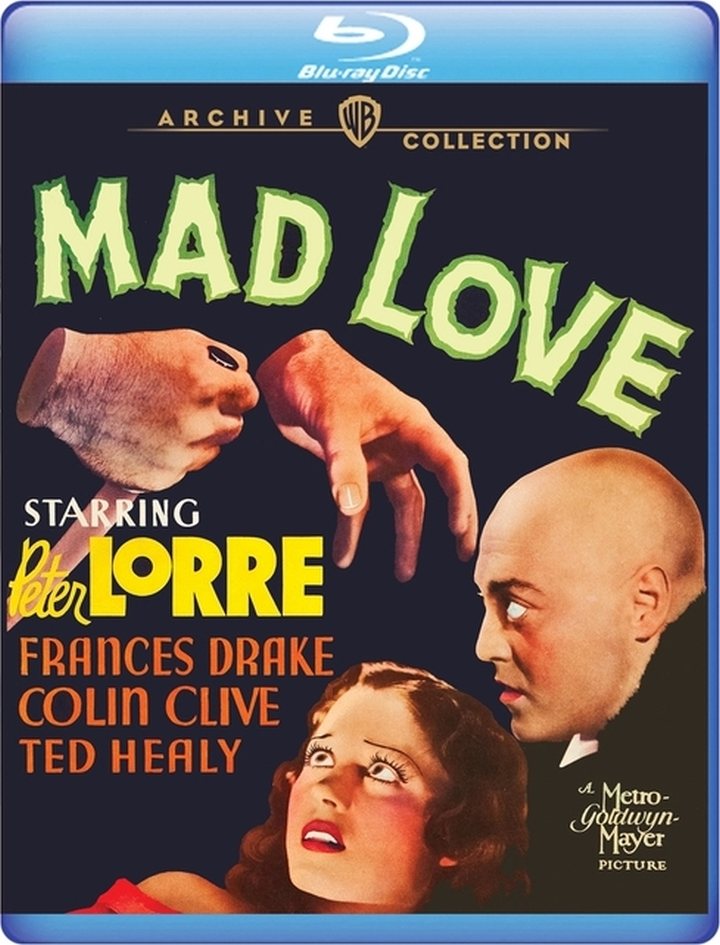
Mad Love would be a long lost Universal horror film had it not been made by MGM. It has a mad doctor, a weird experiment, a sense of the grotesque and a cinematic beauty that places above many of its contemporaries. It’s also the American debut of Peter Lorre, who plays the man madly in love from the title.
Lorre’s Dr. Gogol is in love with Yvonne Orlac, an actress at a Grand Guignol style horror theater. Every night, Gogol pays for a box seat to watch Yvonne be tortured to death in various grotesque plays. The Grand Guignol is one of the most fun scenes in the movie, with the ticket taker in a grotesque devil mask, and the hat check girl completely headless. They’re all as cordial as can be to the nightly visitor, but he only has eyes for Yvonne.
Unfortunately for him, she’s only got ears for her husband, the brilliant pianist Stephen Orlac. He’s played by Colin Clive, who seems almost as unhinged as his portrayal of Dr. Frankenstein, and that’s before he gets his precious hands smashed in a train crash. The doctors say they’ll have to amputate, but instead Yvonne has his wounded body shipped to Dr. Gogol, who is reputed to be a surgical genius.
Coincidentally, Dr. Gogol at that moment is watching the execution of a murderer, a circus knife thrower. When he discovers Yvonne’s need for him, he comes up with an unorthodox method of saving Orlac’s hands: a transplant, with the hands from a recently dead body.
The surgery is kept a secret, but even on the long road to recovery, Orlac can tell something isn’t right. His hands can no longer play piano but develop the strange ability to throw knives with amazing felicity. And he says they fill him with a desire… for murder.
It’s one of the hoariest storylines in horror. The part of someone else’s body carrying on their personality, their skills, and their obsessions. And The Hands of Orlac, the 1920 novel on which this film is based, might be the modern origin for the trope.
But Mad Love is a kitchen sink sort of horror tale, and so the fact that Orlac’s hands might want him to commit murder is only a small part of the overall story. The horror here is primarily focused on Dr. Gogol’s obsessions. His love for Yvonne is so complete he has a wax statue of her in his house, which he plays to every night on the organ. He wants to drive Stephen away, and goes further and further in his plots to do so.
Mad Love was the final film directed by Karl Freund, who was more famous as a cinematographer and went back to that work when this film failed to set the box office on fire. He had worked in Germany, famously for Murnau with The Last Laugh and Fritz Lang with Metropolis. When he came to the states he worked as a cinematographer on Tod Browning’s Dracula, and directed The Mummy with Boris Karloff. On Mad Love he worked with cinematographer Gregg Toland, who would go on to be Orson Welles cinematographer on Citizen Kane.
Mad Love looks like a German expressionist film. While the Orlac home looks normal, Dr. Gogol’s house has painted shadows, and strange proportions. Some scenes are shot entirely in shadows. When Gogol slips further and further into madness, his point of view becomes less realistic and more symbolic.
The film is far from perfect, with the typical ’30s horror movie vice: unfortunate “comic” performances. Here, it’s a news reporter and Gogol’s drunk maid often spoiling the atmosphere. Foregrounding Gogol’s madness means turning the extraordinary idea of the possession of dead limbs by their former owners into a mere side plot, which is strange. But it does lead to one of the most extraordinary and creepy scenes in early American horror, where Gogol masquerades as the donor of the hands, revived from the dead. It’s chilling and bizarre, a bit of rare absolute madness in the often staid early American horror landscape.
Mad Love runs at 68 minutes, and reportedly had 15 minutes of its running time excised before it was ever distributed. What remains is a rather brisk and happily grotesque tale of cinematic madness. The expressionistic techniques are fun to watch, and Peter Lorre’s performance of ever spiraling madness is glorious. And it does what the best of German expressionist films do, even when their stories may not always come together: creates evocative images that resonate.
Mad Love has been released on Blu-ray by Warner Archive collection. Extras include a commentary by Steve Haberman, and the film’s trailer.